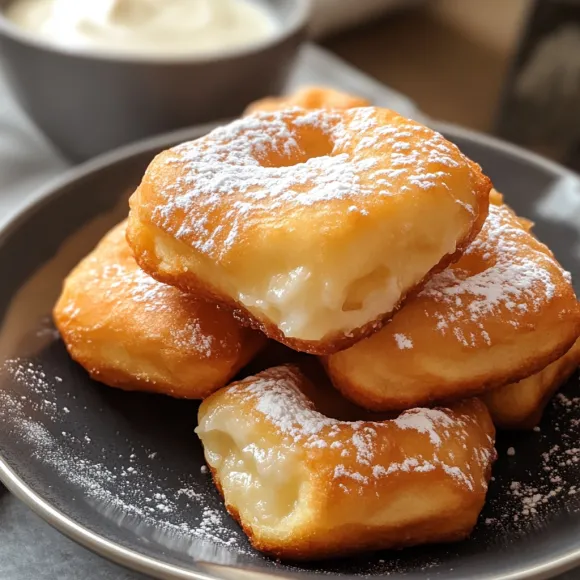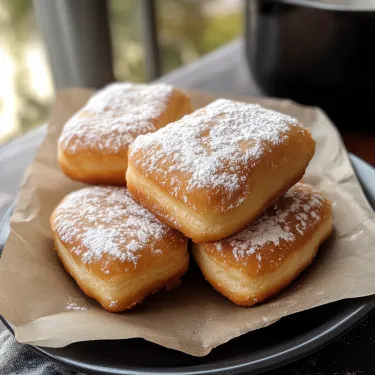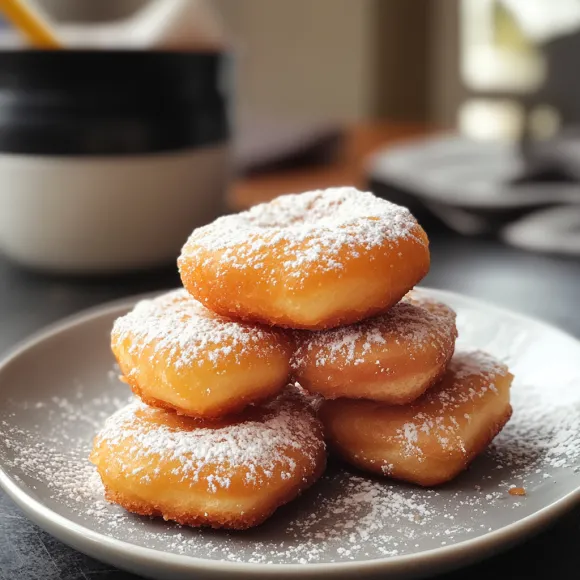 Bookmark
Bookmark
Vanilla's delicate scent turns these French beignets into a treat that feels like eating a cloud. Each one has a perfectly crisp edge with a dreamy coating of powdered sugar. You’ll only need kitchen basics and some hands-on time—great for breakfast or whenever you feel like spoiling yourself or friends.
I served these at my nephew's birthday brunch and everyone grabbed seconds before they touched anything else. If you crave a cozy sweet, these will bring that old-school magic.
Dreamy Ingredients
- Powdered sugar: coats the tops so each bite melts right away Sift for smoothness
- Vegetable oil for frying: lets the dough puff up and taste crisp Go with a neutral oil that can get really hot
- Pure vanilla extract: gives that classic aroma Stick to real vanilla for knockout flavor
- Unsalted butter melted: makes the dough so tender Use the real deal for best taste
- Warm milk: wakes up the yeast Whole milk creates a richer dough
- Salt: brings out the flavor Use fine salt for a good mix
- Active dry yeast: adds just the right lift Double check it’s fresh for the fluffiest beignets
- Granulated sugar: brings a little sweetness Try to use organic for an extra touch
- All purpose flour: keeps the dough chewy but light Unbleached flour works best if you have it
Step by Step Instructions
- Cooling:
- If you’re not ready to eat them right away, set beignets on a wire rack to keep the outside crisp and insides super soft
- Serve:
- Dust warm beignets with loads of powdered sugar and set them out while they’re still fresh and cozy
- Fry the Beignets:
- Drop the dough squares carefully into the hot oil and fry for a minute or two on each side Flip them with tongs until golden brown, then set on paper towels to drain
- Heat the Oil:
- Add enough oil to a heavy pot so it’s at least two inches deep Heat up over medium high When a test piece of dough bubbles soon as it hits the oil and your thermometer reads 360 it’s ready for action
- Shape the Beignets:
- After the first rise punch the dough down and roll it out to about a quarter inch thick Cut into squares about two inches wide so they cook evenly
- First Rise:
- Place the dough in a greased bowl and turn to coat, then cover with a towel Let it get puffy in a warm spot for ninety minutes
- Knead the Dough:
- Move dough to a floured countertop and knead it with your hands for about 8-10 minutes Stop when it’s smooth and stretchy but not too sticky Dust with more flour if things get messy
- Combine Dry and Wet Ingredients:
- Pour wet stuff into dry stuff slowly and stir with a wooden spoon Mix until there’s no more dry flour left and expect a sticky dough
- Mix the Wet Ingredients:
- Stir together warm milk, melted butter, and vanilla in a bowl The liquid should feel warm but not hot so the yeast can do its job
- Prepare the Dry Ingredients:
- Whisk flour, sugar, yeast, and salt together in a big bowl Mix well so the yeast spreads out evenly in the dough
 Bookmark
Bookmark
Vanilla always reminds me of baking with my grandma who only used real extract I still use her trick and now every batch brings back those sweet memories
Storage Tips
Let leftover beignets cool completely then tuck them in an airtight container on the counter They’re tastiest for up to a day If you want to keep them longer, freeze on a tray then heat in a three hundred degree oven for five to eight minutes so they turn soft again
Ingredient Swaps
No all purpose flour? Bread flour works but your beignets will be a bit chewy Try almond or oat milk plus coconut oil for a dairy free version Just make sure your milk is only warm, so your yeast stays happy
Serving Ideas
Pile up warm beignets and cover them in powdered sugar For a fun touch, pack them with jam or lemon curd when they’re still hot or dip in fruit sauce or hot chocolate
 Bookmark
Bookmark
Fun Background
These French treats made their way to New Orleans with early French settlers Now you’ll see them in cafes all around town, always topped with a thick layer of powdered sugar and soft airy dough
Frequently Asked Questions About Recipes
- → Which flour gives the softest beignets?
Plain, all-purpose flour does the trick for fluffy, melt-in-your-mouth French beignets.
- → Why bother kneading the dough so much?
Kneading helps the dough get stretchy, so your beignets come out springy and light after frying.
- → How can I tell if my frying oil's ready?
Grab a thermometer and make sure the oil holds at 360°F. That way, your beignets are crisp, not oily.
- → Is it possible to make these ahead of time?
They're at their peak right away, but you can pop leftovers in the oven at 300°F to perk them up again.
- → What's the best way to eat beignets?
Dust them with powdered sugar and serve while still hot from the oil. That's when they're most delicious.
- → Why add vanilla extract to the dough?
Vanilla gives the dough a sweet aroma and cozy flavor that matches the sugary finish perfectly.
